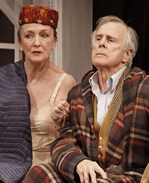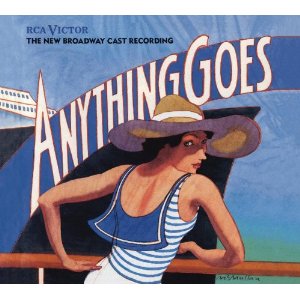SITE GUIDE
SEARCH
REVIEWS
REVIEW ARCHIVES
ADVERTISING AT CURTAINUP
FEATURES
NEWS
Etcetera and
Short Term Listings
LISTINGS
Broadway
Off-Broadway
NYC Restaurants
BOOKS and CDs
OTHER PLACES
Berkshires
London
California
New Jersey
DC
Philadelphia
Elsewhere
QUOTES
TKTS
PLAYWRIGHTS' ALBUMS
LETTERS TO EDITOR
FILM
LINKS
MISCELLANEOUS
Free Updates
Masthead
A CurtainUp Review
Painting Churches
By Elyse Sommer
|
If you want to paint us so badly, you ought to paint us as we really are! — Fanny, to her artist daughter who has yet to truly understand the changed dynamic between her parents and exactly why they are moving out of their spacious Beacon Hill home.
|

Kathleen Chalfant and John Cunningham
(Photo credit: Carol Rosegg) |
As Mags sets up her portrait amidst all the packing up, a lot of emotional baggage is unpacked so that the audience, and not just Mags, gets to see the Churches — as they were, and as they are. That means that we learn why Mags has been such an infrequent visitor to the gracious Beacon Hill home and the distinguished Brahmin parents she nevertheless loves and whose approval she still covets. We also learn to look beneath the eccentric Fanny's relentless chatter and vivacity.
This quiet, little play was a breakthrough for Tina Howe, winning much praise (and almost a Pulitzer) for the way it explored dual dual themes — the problems of aging and a grown daughter's having to put aside conflicting feelings about a difficult mother to see the devotion and strength beneath her rigidity. Howe built her story around Fanny and Gardner Church's final days in Boston's crème-de-la-crème Beacon Hill area. The senior Churches' lives are on a downward spiral — financially and in terms of Gardner's career as a published poet who once won a Pulitzer-Prize and palled around with the likes of Robert Frost . On the other hand, Mags' career as an artist is moving into high gear. But as Mags can't feel truly successful without her parents approval, so Fanny isn't quite as breezy and almost festive about the move as she seems to be.
And so, Fanny reminisces non-stop as she wraps the family silver and tries on her designer thrift shop treasures. . . Mags creates a setting for the parental portrait . . . . and Gardner wanders in and out from the study where his failing memory has him work at a book that's a mere jumble of typed copies of the poems he sill know by heart. Thus, bit by bit, the details of the family dynamic, past and present, crystallizes. While Fanny was indeed a tough mother (it was her dealing with Mags's eating problem that remains a festering wound even though it triggered her career as an artist), her current impatience (as Mags sees it, her cruelty) with Gardner is the weary exasperation of a frightened, harried care giver.
The Churches move to a summer resort cottage is undoubtedly a terrible choice, given Gardner's problem, which thirty years ago was still not commonly identified as Altzheimer's. It's a condition that's going to get worse before it gets better and the Churches' modern day counterparts would probably sell both their homes (even in a bad economy Beacon Hill and Cape Cod real estate is still prime) and move into one of Boston's several upscale assisted living apartment complexes. But then Ms. Howe's Churches are unique period pieces so I suppose a revival should be "as is" and rely on the actors and the play's inherent delicacy to carry the day. And there's the rub.
Carl Forsman, the Keen's artistic director who also directed the companys's revival of Howe's Museum ten years ago, is certainly blessed to have Kathleen Chalfant and John Cunningham as the aging Boston Brahmins whose love for each other must pass the test of their not so golden years. However, his tempo is too slow and he's directed the actors, especially Chalfant, to overplay their eccentric ways. This is especially true of the beginning when Fanny pretty much dominates Beowulf Borit's nicely designed living room as she holds a conversation with herself about the meaning and value of the family treasures being sorted into boxes to go to an auction house and boxes to take with them. Given the directorial emphasis on shtick, even a magnificent pro like Chalfant can't prevent Fanny's interrupting herself to get Gardner's attention from coming off more shrill than amusing.
This emphasis on a too broadly jokey tone tends to also put a spotlight on some of the dated aspects of the script. Unless you're collecting social security, the joke about a Lily Dache label in both Fanny's thrift shop pillbox hat and Gardner's sweater is not going to have you fall off your seat laughing. That's not to say that Chalfant's numerous costume changes courtesy of Jennifer Paar aren't fun fun. She carries off even a scene in satin slip and hat with the ladylike aplomb that defines her character.
The pace does pick up with the arrival of Megs though Kate Turnbull doesn't really give her character the emotional depth called for. The confrontation between mother and daughter would be a lot more powerful if Chalfant didn't have to do all the heavy lifting. John Cunningham's Gardner does manage to steal your heart and Howe's more airy humor surfaces occasionally, as when we see Chalfant and Cunningham contentedly chomp away at a box of saltine crackers.
Does Mags finish her portrait? The answer is yes. However, the only portrait the audience sees, and the one that Mags herself comes away with, is that of the flesh and blood Fanny and Gardner's touching finale.
|
Painting Churches by Tina Howe Directed by Carl Forsman. Cast: Kathleen Chalfant (Fanny), John Cunningham (Gardner), Kate Turnbull (Mags) Set: Beowulf Boritt Lighting: Josh Bradford Costumes: Jennifer Paar Sound: Ryan Rumery Properties: Ricola Wille Stage Manager: Jeff Meyers Running Time: 2 hours, including one 15-minute intermission Keen Company at Clurman Theatre 410 West 42nd Street 212.239.6200 Tuesday at 7pm, Wednesday - Friday at 8pm, Saturday at 2pm & 8pm. Sunday at 3pm Tickets: $59.75 Reviewed by Elyse Sommer at 3/03 press matinee. |
|
REVIEW FEEDBACK Highlight one of the responses below and click "copy" or"CTRL+C"
Paste the highlighted text into the subject line (CTRL+ V): Feel free to add detailed comments in the body of the email. . .also the names and emails of any friends to whom you'd like us to forward a copy of this review. Visit Curtainup's Blog Annex For a feed to reviews and features as they are posted add http://curtainupnewlinks.blogspot.com to your reader Curtainup at Facebook . . . Curtainup at Twitter Subscribe to our FREE email updates: E-mail: esommer@curtainup.comesommer@curtainup.com put SUBSCRIBE CURTAINUP EMAIL UPDATE in the subject line and your full name and email address in the body of the message. If you can spare a minute, tell us how you came to CurtainUp and from what part of the country. |

Slings & Arrows- view 1st episode free
 Anything Goes Cast Recording
Anything Goes Cast RecordingOur review of the show
 Book of Mormon -CD
Book of Mormon -CDOur review of the show

